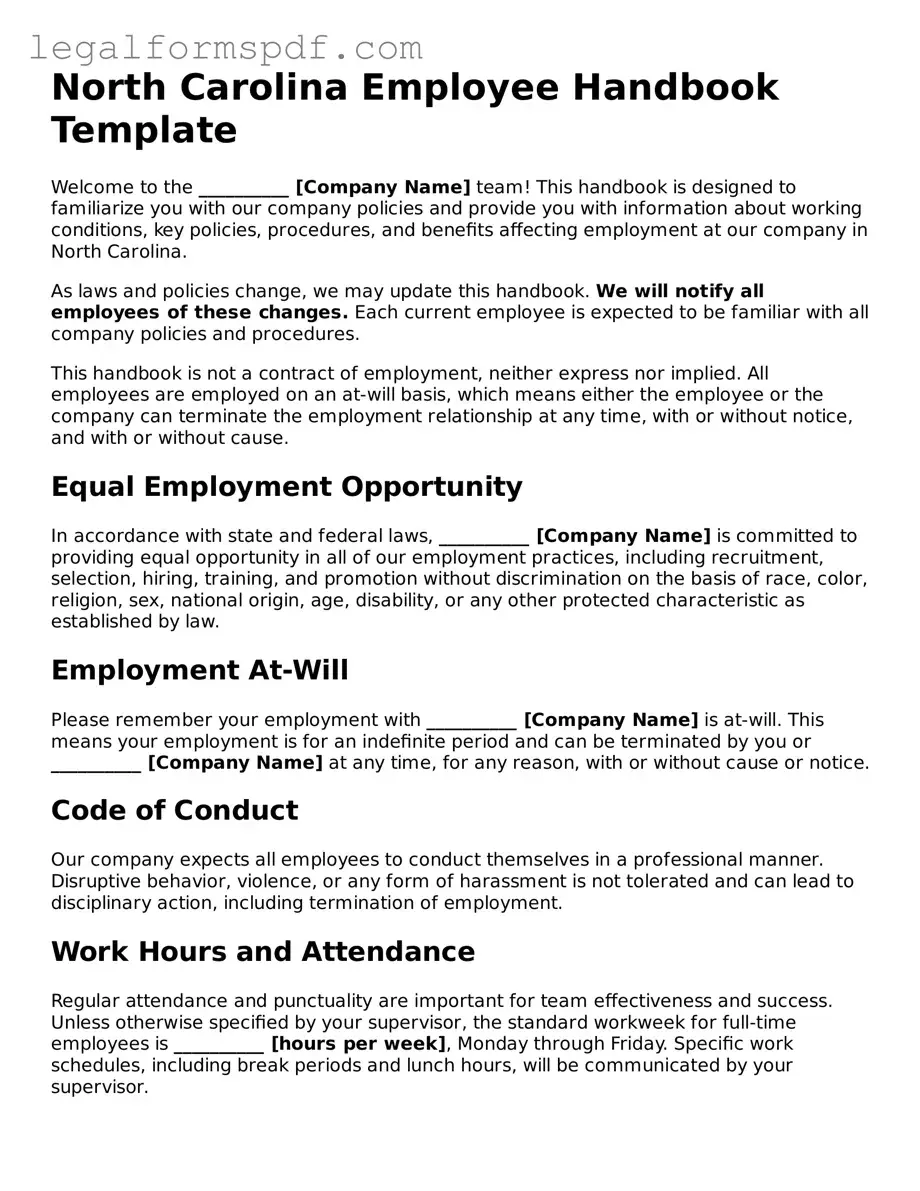North Carolina Employee Handbook Template
Welcome to the __________ [Company Name] team! This handbook is designed to familiarize you with our company policies and provide you with information about working conditions, key policies, procedures, and benefits affecting employment at our company in North Carolina.
As laws and policies change, we may update this handbook. We will notify all employees of these changes. Each current employee is expected to be familiar with all company policies and procedures.
This handbook is not a contract of employment, neither express nor implied. All employees are employed on an at-will basis, which means either the employee or the company can terminate the employment relationship at any time, with or without notice, and with or without cause.
Equal Employment Opportunity
In accordance with state and federal laws, __________ [Company Name] is committed to providing equal opportunity in all of our employment practices, including recruitment, selection, hiring, training, and promotion without discrimination on the basis of race, color, religion, sex, national origin, age, disability, or any other protected characteristic as established by law.
Employment At-Will
Please remember your employment with __________ [Company Name] is at-will. This means your employment is for an indefinite period and can be terminated by you or __________ [Company Name] at any time, for any reason, with or without cause or notice.
Code of Conduct
Our company expects all employees to conduct themselves in a professional manner. Disruptive behavior, violence, or any form of harassment is not tolerated and can lead to disciplinary action, including termination of employment.
Work Hours and Attendance
Regular attendance and punctuality are important for team effectiveness and success. Unless otherwise specified by your supervisor, the standard workweek for full-time employees is __________ [hours per week], Monday through Friday. Specific work schedules, including break periods and lunch hours, will be communicated by your supervisor.
Leave Policies
__________ [Company Name] offers various types of leave, including:
- Vacation Leave
- Sick Leave
- Bereavement Leave
- Jury Duty Leave
- Family and Medical Leave in accordance with the North Carolina Family Leave Act (where applicable)
For details on eligibility and application procedures for leave, please refer to the specific policies or contact HR.
Benefits
Eligible employees at __________ [Company Name] are provided with a range of benefits. A summary of the benefits available includes:
- Health Insurance
- Dental Insurance
- Retirement Savings Plan
- Employee Assistance Program (EAP)
For more detailed information on each benefit program, please refer to the benefits summary provided to you during your orientation or contact HR.
Workplace Safety
Workplace safety is a primary concern of __________ [Company Name]. All employees are expected to adhere to safety guidelines and report any hazards or injuries to their supervisor or the safety officer immediately.
Employee Acknowledgment
This handbook is intended to provide you with a general overview of our policies and procedures. It is not all-inclusive and should be used as a guide only. You are responsible for reading, understanding, and complying with all policies and procedures outlined in this handbook.
I acknowledge that I have received and read the __________ [Company Name] Employee Handbook. I understand that it is my responsibility to comply with the policies and procedures contained therein and that failure to do so may result in disciplinary action, up to and including termination of employment.
Employee Signature: __________________________________ Date: __________
Supervisor Signature: _______________________________ Date: __________
